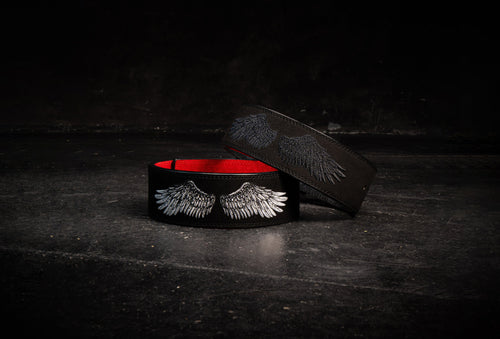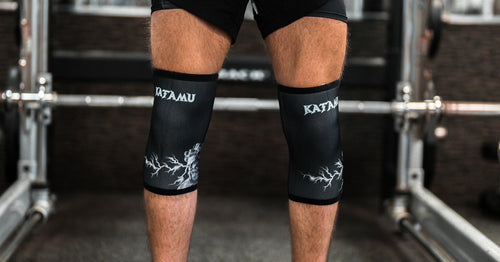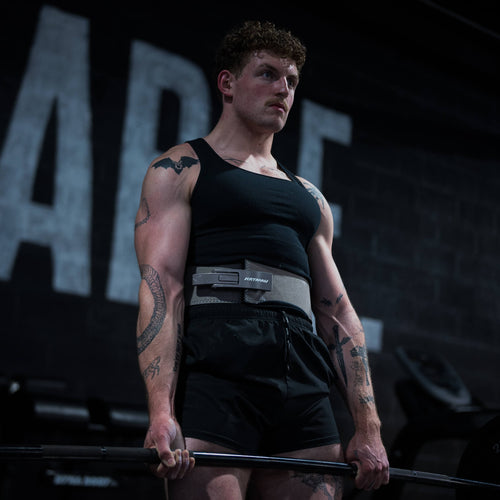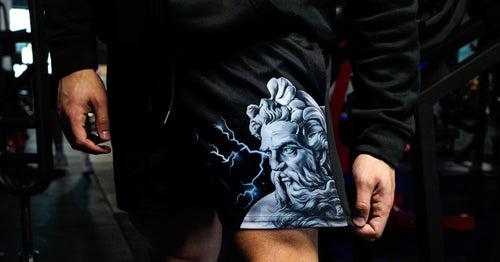Ready to transform your lifts in 2025? The sbd weightlifting belt is the secret weapon trusted by elite athletes and dedicated gym enthusiasts. This guide gives you expert tips and practical steps so you can choose, use, and get the most from your belt. Discover how the right belt can boost your performance, protect your core, and build confidence under the bar. We break down features, sizing, comparisons, care, and pro advice to help you train smarter and safer—no matter your experience level.
Understanding SBD Weightlifting Belts: Features & Benefits
Unlocking your strength potential starts with the right gear. The sbd weightlifting belt has become a staple in gyms and on competition platforms for both elite powerlifters and dedicated enthusiasts. But what truly sets this belt apart, and why do so many lifters trust it to support their biggest lifts?
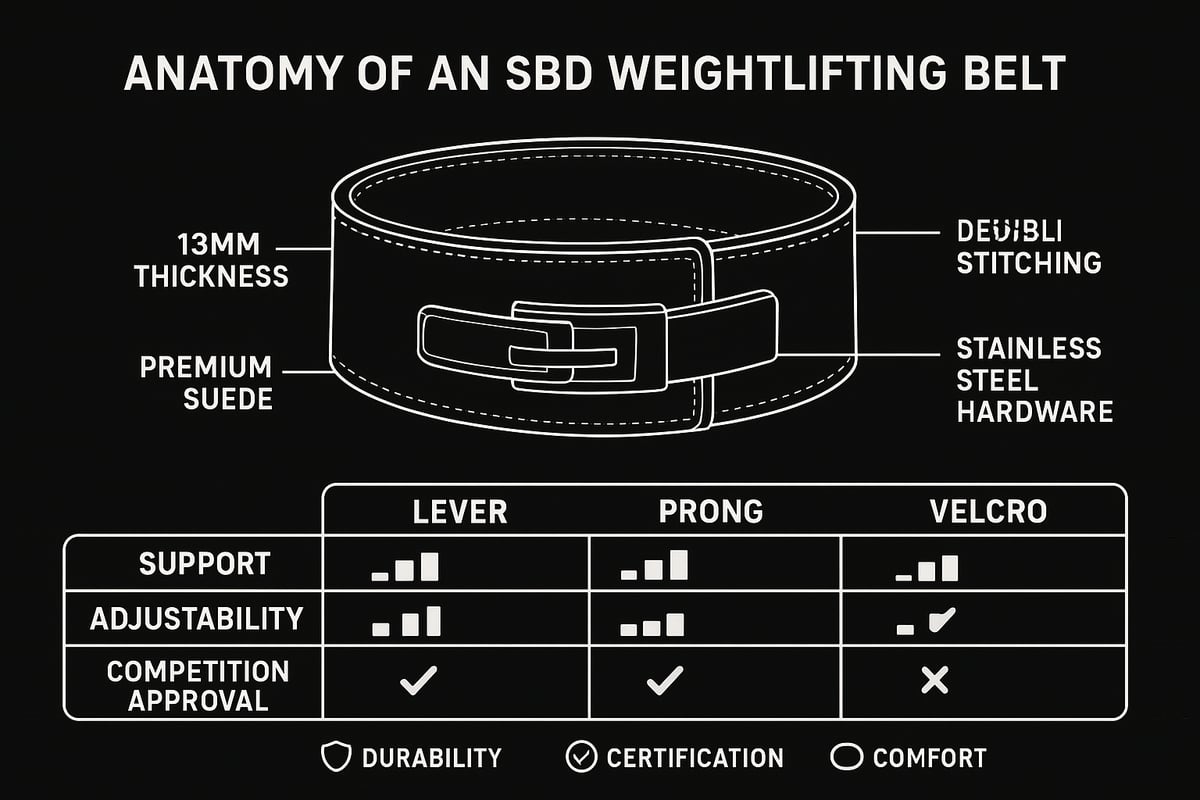
What Sets SBD Belts Apart
The sbd weightlifting belt is synonymous with quality and high performance. SBD has built a reputation for delivering belts trusted at the highest levels, including the IPF World Championships. With a robust 13mm thickness, the belt provides optimal rigidity without sacrificing comfort. The stainless steel lever buckle allows for rapid adjustments and a secure fit, which is a game-changer during heavy attempts.
SBD uses premium suede and double-stitching to ensure long-term durability. The materials are selected to withstand years of intense training, while the contoured design helps the belt mold naturally to your body after a brief break-in period. This attention to detail means the sbd weightlifting belt offers both support and comfort, even during maximal lifts.
One of the defining features is its lever buckle system. Unlike prong or velcro belts, the lever mechanism lets you tighten or loosen the belt instantly. Curious about the advantages of lever belts? Check out the Lever Belt Weightlifting Advantages guide for an in-depth look at why many lifters prefer this system.
For competitive lifters, SBD’s IPF and USAPL certifications matter. These approvals mean your belt is legal in top-tier competitions, giving peace of mind to powerlifters aiming for the platform. In fact, over 60% of elite powerlifters now use lever belts like the sbd weightlifting belt, according to Powerlifting Today (2023).
Comfort is key, too. The design reduces pinching and allows for a snug fit that still permits proper breathing and bracing. Whether you’re a seasoned competitor or a dedicated gymgoer, you’ll notice the difference in fit and support from your first session.
Key Benefits for Lifters
Why choose an sbd weightlifting belt over other options? The benefits start with improved core stability. By creating consistent intra-abdominal pressure, the belt helps stabilize your spine during squats, deadlifts, and presses. This added support can significantly reduce the risk of injury, especially when handling heavy weights.
Performance gains are another major advantage. Many lifters report hitting new personal bests after integrating an sbd weightlifting belt into their routine. The psychological confidence boost from feeling secure under the bar cannot be understated.
The sbd weightlifting belt is designed for everyone, from beginners learning proper bracing to advanced athletes chasing records. Its lever system makes it easy to achieve the right tightness for each lift, supporting gradual progress without over-reliance.
How does it compare to other belt types? Here’s a quick look:
| Belt Type | Support | Adjustability | Competition Approval | Break-in Period |
|---|---|---|---|---|
| SBD Lever | High | Easy | IPF/USAPL | Moderate |
| Prong | Moderate | Manual | IPF/USAPL | Short |
| Velcro | Low | Quick | Not approved | Minimal |
Lever belts like the sbd weightlifting belt stand out for their blend of support, convenience, and reliability. While prong belts are solid, they can be harder to adjust quickly. Velcro belts offer speed but lack the stiffness and competition approval serious lifters need.
In summary, the sbd weightlifting belt delivers a unique mix of support, durability, and performance that has made it the top choice for lifters at every level. Whether you are training for a meet or simply aiming to move more weight safely, this belt is built to help you reach your goals.
Sizing, Fit & Selection Guide: Choosing Your SBD Belt
Choosing the right sbd weightlifting belt is essential for comfort, safety, and optimal lifting performance. The correct fit ensures you get the full benefits of support and stability, while the right model aligns with your training needs and style preferences. Here’s how to confidently select the perfect belt for your lifting journey.
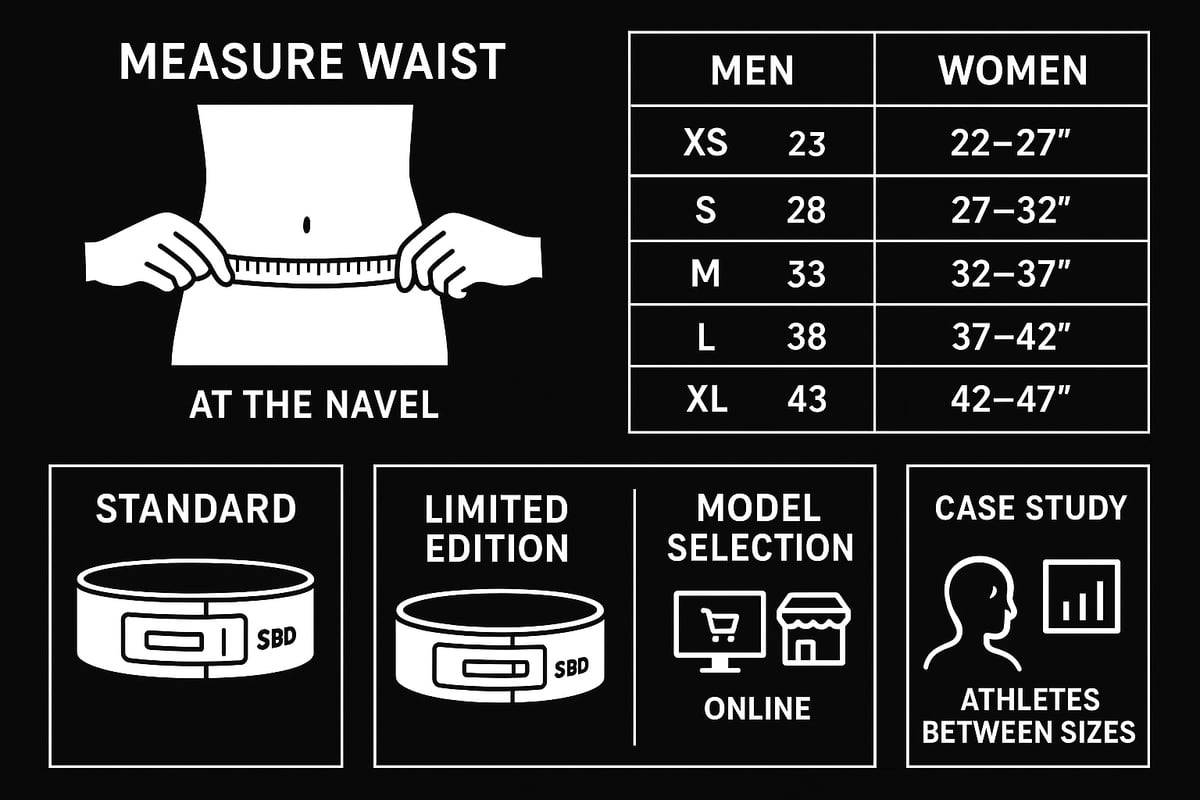
How to Measure and Select the Right Size
Finding the ideal fit for your sbd weightlifting belt starts with accurate measurement. Use a flexible tape to measure your waist at the navel, not over your clothes. Stand relaxed and exhale gently—avoid sucking in or pushing out your stomach.
Once you have your measurement, compare it to the official SBD sizing chart. Interpreting your number correctly is crucial. If you fall on the border between sizes, consider your training style and whether you prefer a snug or slightly looser fit. For detailed guidance, refer to the SBD Belt Size Guide to confirm your choice.
Men’s and women’s belts may have different proportions, so check the chart designed for your body type. Common mistakes include measuring over bulky clothing or using pant size instead of actual waist circumference.
Adjusting the lever position is the final step. The lever offers micro-adjustments for a personalized fit, allowing you to dial in support for different lifts. If you’re between sizes, a case study shows that athletes often size down for a tighter brace during heavy lifts, but those prioritizing comfort may size up.
When buying online, double-check return policies and reviews, as trying the sbd weightlifting belt in-store allows for immediate feedback on fit. Take your time—proper sizing is the foundation for safe and effective lifting.
Selecting the Right Model for Your Needs
After finding your size, it’s time to choose the sbd weightlifting belt model that matches your goals. The standard SBD belt offers classic black and red styling, while limited edition releases provide unique colors and finishes for a personalized touch.
Customization options extend to lever types, with some models featuring a matte or polished finish. While aesthetics are a factor, focus on functionality first. The lever buckle is a signature of SBD, providing consistent tightness and easy adjustments between sets.
Budget is another consideration. SBD belts are a premium investment, but their durability and competition approval add long-term value, especially compared to generic belts. If you’re upgrading from a beginner belt, look for signs like worn stitching, lack of support, or failed buckles—these indicate it’s time to invest in a higher-quality option.
Online forums and user reviews can help you decide if a standard or limited edition sbd weightlifting belt fits your training style. Evaluate your needs, set your budget, and remember that the right belt can elevate your performance and confidence in every lift.
How to Use Your SBD Weightlifting Belt: Step-by-Step Guide
Unlocking the full potential of your sbd weightlifting belt begins with proper setup, correct wear, smart integration into your training, and knowing how to troubleshoot common issues. Follow this step-by-step guide to ensure you get the most out of your investment and support your lifting journey with confidence.
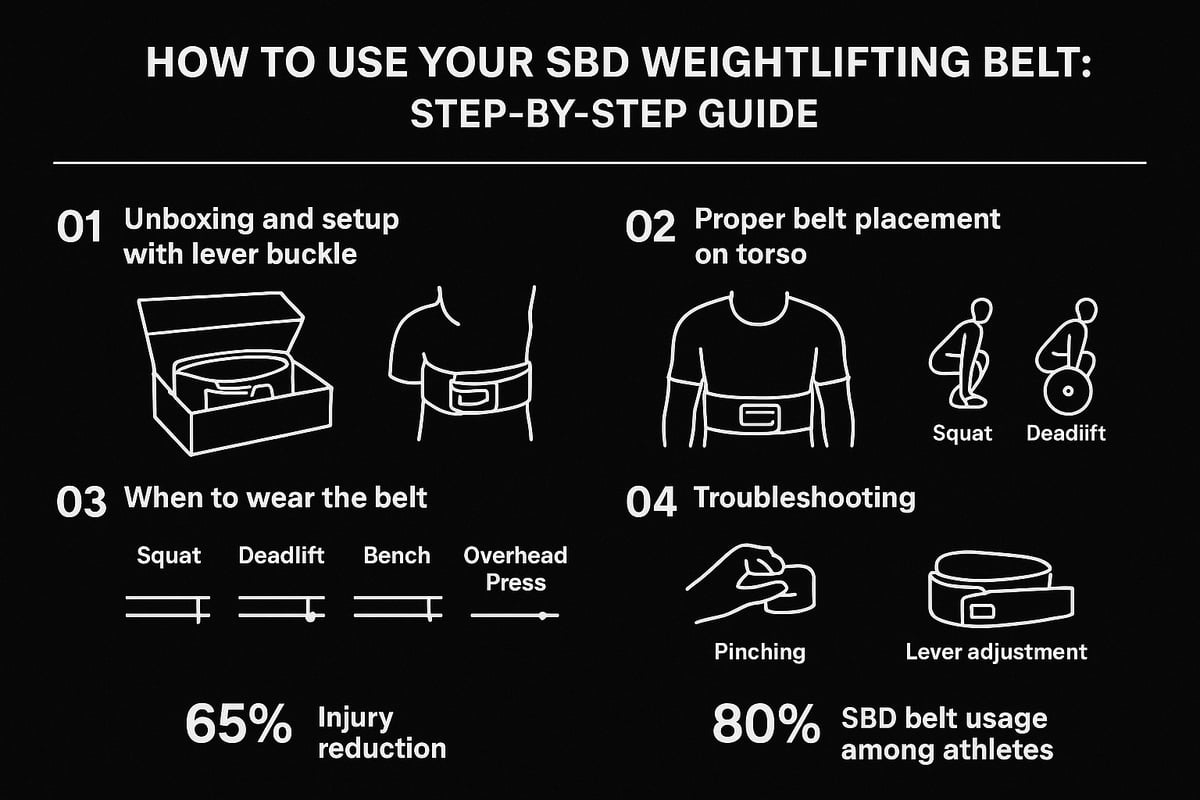
Step 1: Setting Up Your Belt
When your new sbd weightlifting belt arrives, start by carefully unboxing and inspecting the materials. Check the stitching, lever mechanism, and suede for any manufacturing defects. High-quality construction is a hallmark of SBD, so expect a solid feel.
Next, attach the lever buckle. The lever system allows for easy adjustments and a secure fit. Follow the included instructions to fasten the lever to your desired notch. Ensure it clicks firmly into place, as a loose lever can compromise support.
Orient the belt so the SBD logo faces outward and the buckle sits in front. The belt should wrap evenly around your midsection, not twisted or uneven. Before your first heavy session, wear the sbd weightlifting belt for short periods to begin the break-in process. The thick suede may feel stiff initially, but it will mold to your body over several sessions.
Many lifters find the break-in period lasts about two weeks. During this time, use the belt for lighter sets and gradually increase duration. This helps the sbd weightlifting belt conform to your waist while maintaining its rigidity.
Step 2: Wearing the Belt Correctly
Wearing your sbd weightlifting belt properly is essential for both safety and performance. Start by positioning the belt at the optimal height on your torso. For squats, most athletes place it just above the navel, while deadlifters often wear it slightly lower to allow hip movement.
Tighten the belt so it feels snug but not restrictive. You should be able to slide a finger between your body and the belt. The aim is to provide support without impeding your ability to breathe or brace. Over-tightening can hinder your performance and comfort.
Breathing technique is key. Take a deep breath into your belly, pushing against the belt to create intra-abdominal pressure. This pressure stabilizes your core and protects your spine. Elite lifters use this method to maximize their lifts, often setting the sbd weightlifting belt tighter for squats and slightly looser for deadlifts.
Experiment with belt height and tightness to find your ideal setup. Remember, your sbd weightlifting belt should enhance—not limit—your movement and confidence during heavy lifts.
Step 3: Using the Belt in Your Training Routine
Knowing when and how to use your sbd weightlifting belt is crucial for progress and injury prevention. Do not wear the belt for every set. Reserve it for working sets, especially when lifting at 80% or more of your max. This approach helps you build raw core strength during warm-ups and lighter lifts.
For squats and deadlifts, the sbd weightlifting belt provides the most benefit by stabilizing your core. During bench press and overhead press, some lifters use the belt for added support, but it's optional. Adjust the fit between exercises if needed.
Integrate the belt gradually into your routine. Over-reliance can weaken your natural bracing ability. Aim to use the sbd weightlifting belt as a tool, not a crutch. Research in the Strength & Conditioning Journal (2022) shows that proper belt use can reduce lower back injuries by up to 25 percent.
For more practical guidance on using belts in your training, check out these Gym Belt Weightlifting Tips to refine your approach.
Step 4: Troubleshooting Common Problems
Even the best sbd weightlifting belt may need occasional adjustments. If you experience pinching or bruising, check the placement and tightness. Sometimes, wearing the belt over a thin shirt or adjusting the height by a centimeter can eliminate discomfort.
Lever slippage or malfunction is rare, but if it occurs, ensure the screws are tight and the lever is fully engaged. Carry a small screwdriver in your gym bag for quick fixes. If the belt feels too loose or too tight, revisit your lever setting. You may need to move the lever to a different notch as your body changes.
Sizing issues are common, especially after weight fluctuations. If you consistently struggle with fit, consider resizing or consulting SBD’s customer support. Many lifters share stories of solving fit problems simply by making small adjustments to the lever or belt position.
Stay proactive with your sbd weightlifting belt care and fit, and you will enjoy years of reliable support in your training.
SBD Belt Maintenance & Longevity Tips
A well-maintained sbd weightlifting belt is an investment in your safety and performance. Regular care not only preserves its appearance but also ensures that your belt delivers consistent support every time you lift.

Cleaning and Caring for Your Belt
Keeping your sbd weightlifting belt clean is essential for comfort and durability. Start by wiping down the suede with a dry, soft brush after each workout to remove chalk and debris. For deeper cleaning, use a damp cloth with mild soap, but avoid soaking the leather or suede to prevent damage.
Never use harsh chemicals or submerge your sbd weightlifting belt in water. To tackle sweat and odors, sprinkle a small amount of baking soda on the suede, let it sit for a few hours, then brush it off gently. Always air dry your belt completely before storing it.
Proper storage is equally important. Hang your sbd weightlifting belt or lay it flat in a cool, dry place away from direct sunlight. Avoid folding or crumpling the belt, as this can cause warping and creasing over time.
For the lever, check periodically for loose screws or stiffness. Use a drop of light oil to keep the mechanism smooth and tighten any hardware as needed. Regular care will keep your sbd weightlifting belt performing at its best.
Maximizing Belt Lifespan
With the right maintenance, an sbd weightlifting belt can last for years. Watch for signs of wear, such as fraying stitches, cracks in the leather, or lever malfunction. If the belt loses its rigidity or the buckle becomes unreliable, it may be time to replace it.
SBD offers a robust warranty and responsive customer support, which is a major advantage over generic belts. Many lifters report their sbd weightlifting belt lasting over five years with proper care, far outpacing cheaper alternatives.
Here's a quick comparison of longevity:
| Belt Type | Average Lifespan | Warranty |
|---|---|---|
| SBD Weightlifting Belt | 5+ years | Yes (Limited) |
| Generic Leather Belt | 1–2 years | Varies |
For more on real-world durability and user experiences, check out this SBD Powerlifting Belt Review 2023. Staying attentive to maintenance and early signs of wear will ensure your sbd weightlifting belt remains a reliable training partner for years to come.
SBD vs. Other Weightlifting Belts: Expert Comparison for 2025
Choosing the right lifting belt can make or break your training progress. When comparing the sbd weightlifting belt with other options, lifters notice differences in support, stiffness, and adjustability. SBD's 13mm lever design delivers unmatched rigidity, which means more reliable core bracing on heavy lifts. In contrast, prong belts offer more micro-adjustments, but can be slower to put on and take off. Velcro belts are lightweight and easy to use, yet lack the support needed for maximal lifts. Lever belts, especially from SBD, are trusted at the highest levels for their consistent performance.
SBD belts stand out for their official approval by the IPF and USAPL, making them the go-to choice for competitive powerlifters. This certification is crucial for anyone aiming to compete, as many federations require approved equipment. The sbd weightlifting belt is also known for its contoured fit and high-quality suede, which reduces the break-in period compared to stiffer competitors. Comfort is a key factor, and SBD’s attention to ergonomic design pays off during long sessions. For a detailed breakdown of how SBD stacks up against other leading brands, see this Powerlifting Belt Comparison.
Price is another consideration. While the sbd weightlifting belt sits at a premium price point, it offers long-term value thanks to its durability and warranty. Compared to brands like Rogue, Inzer, and Titan, SBD belts command a higher upfront investment but often outlast competitors. Many powerlifters switch to SBD after trying other brands and report greater confidence under the bar. According to a 2024 survey, SBD now holds the largest market share among competitive lifters, reflecting its reputation for quality and performance.
Here's a quick side-by-side comparison to help you decide:
| Belt Type | Support | Adjustability | Competition Approved | Comfort | Price |
|---|---|---|---|---|---|
| SBD Lever | Excellent | Good | Yes | High | Premium |
| Prong | Very Good | Excellent | Yes | Moderate | Mid-High |
| Velcro | Low-Moderate | Excellent | No | High | Low |
| Other Lever | Good | Good | Some | Moderate | Varies |
In summary, the sbd weightlifting belt remains a top pick for serious lifters seeking maximum support, lasting comfort, and competition readiness. If you are exploring all your options, check out this Powerlifting Belt Comparison to make an informed choice.
Expert Tips & Advanced Advice for SBD Belt Users
Unlocking the full benefits of your sbd weightlifting belt requires more than just wearing it tight. Mastering advanced techniques and strategies can help you reach new levels of strength and safety in your training.
Maximizing Performance with Your SBD Weightlifting Belt
To truly benefit from your sbd weightlifting belt, start by refining your bracing technique. Advanced lifters use drills such as "360-degree bracing," where you push your core outward in every direction against the belt. Practice this with lighter weights to enhance intra-abdominal pressure and core stability.
Periodization matters, too. Incorporate beltless sets early in your training cycles to develop raw core strength. As your program approaches heavier lifts, gradually increase the frequency of using your sbd weightlifting belt for top sets. This approach prevents over-reliance and supports long-term progress.
During peaking cycles, use the belt consistently on all working sets to maximize performance on competition lifts. Adjust the lever setting slightly tighter for heavy singles, then loosen it for volume work or accessory movements. This customization ensures the sbd weightlifting belt provides optimal support without sacrificing comfort or mobility.
Combining your belt with other supportive gear, such as knee sleeves and wrist wraps, can further boost stability and confidence. For a broader look at how different belts and gear can work together, check out the Best Weightlifting Belts Guide.
Advanced Advice: Customization, Myths & Research
Customizing your sbd weightlifting belt for individual lifts is a game changer. Some athletes prefer a slightly higher belt position for squats, while others shift it lower for deadlifts. Experiment with placement and lever tightness to find what best supports your body mechanics and lifting style.
Many lifters worry about becoming dependent on their belt. Research shows that strategic use of the sbd weightlifting belt actually leads to greater long-term strength gains when combined with beltless training phases. Coaches recommend cycling belt use and always focusing on proper bracing, even when the belt is off.
A common myth is that belts are only for elite powerlifters. In reality, novice and experienced lifters alike benefit from the stability and confidence the sbd weightlifting belt provides. Coaches often tailor advice based on body type, as shorter or longer torsos may require different belt positions.
Integrate your sbd weightlifting belt with other supportive gear as you progress. Stay updated with the latest research, such as findings from the Journal of Strength Research (2023), which highlight improved strength outcomes when belts are used intelligently in well-structured programs.
Now that you know what sets SBD weightlifting belts apart and how they can transform your performance, it’s the perfect time to put that knowledge into action. If you’re ready to invest in a belt that’ll support your lifts, protect your back, and last for years, I’ve got you covered. We’ve got a range of premium lever belts with unique designs at Katamu, built for everyday gymgoers who want serious results. Take the next step and build your setup with gear that matches your goals and style. Your best lifts are just ahead!
